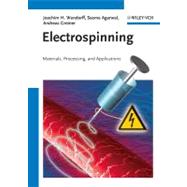
Note: Supplemental materials are not guaranteed with Rental or Used book purchases.
Purchase Benefits
What is included with this book?
| Introduction Nanofibers in General Quick Guide to Electrospinning Other Techniques for Nanofiber Preparation | |
| Detailed Description of Electrospinning Technique Experimental Set-ups Polymer Systems for Electrospinning Complex Material Systems Functional Polymer Systems | |
| Structure of Electrospun Systems Textures of Nonwovens Fiber Properties: Molecular structure (Crystallinity), Morphological Supramolecular Structure Fibers, Morphology of Blends and Composites, Block Copolymer Fibers, Liquid Crystalline Fibers | |
| Theory of Electrospinning | |
| Applications of Electrospun Fibers Filtration / Membranes Textiles Catalysis Sensors Reinforcement Biomedical Applications | |
| Table of Contents provided by Publisher. All Rights Reserved. |
The New copy of this book will include any supplemental materials advertised. Please check the title of the book to determine if it should include any access cards, study guides, lab manuals, CDs, etc.
The Used, Rental and eBook copies of this book are not guaranteed to include any supplemental materials. Typically, only the book itself is included. This is true even if the title states it includes any access cards, study guides, lab manuals, CDs, etc.